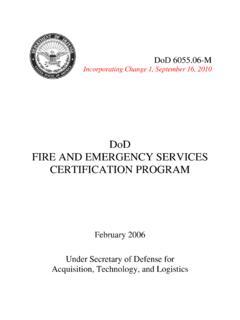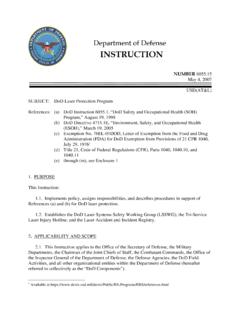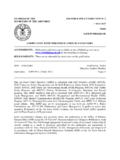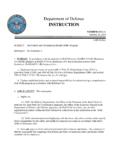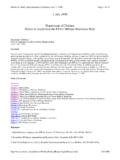Transcription of HEADQUARTERS UNITED STATES AIR FORCE
1 DEPARTMENT OF THE AIR FORCE HEADQUARTERS UNITED STATES AIR FORCE AFI91-208_AFGM2018-01 19 June 2018 MEMORANDUM FOR DISTRIBUTION C MAJCOMs/FOAs/DRUs FROM: HQ USAF/SE 1400 Air FORCE Pentagon Washington DC 20330-1400 SUBJECT: Air FORCE Guidance Memorandum to AFI 91-208, Hazards of Electromagnetic Radiation to Ordnance (HERO) Certification and Management By Order of the Secretary of the Air FORCE , this is an Air FORCE Guidance Memorandum immediately implementing changes to AFI 91-208, Hazards of Electromagnetic Radiation to Ordnance (HERO) Certification and Management. Compliance with this Memorandum is mandatory. To the extent its direction is inconsistent with other Air FORCE publications, the information herein prevails, in accordance with AFI 33-360, Publications and Forms Management. Change the following paragraphs: Multiple MMEs (two or more) are not authorized in enclosed spaces such as magazines or facilities where HERO SUSCEPTIBLE or HERO UNSAFE ordnance is stored or built-up, unless authorized by AFSEC/SEW; the aggregated effects on the ambient or volumetric electromagnetic field in those spaces may increase as a results of complex cavity effects.
2 If the RADHAZ survey included the use of two or more AFSEC/SEW approved MMEs while maintaining EME levels that did not exceed HERO EME levels for ordnance (HERO SUSCEPTIBLE or HERO UNSAFE), multiple MMEs are permissible. Use of multiple MMEs inside enclosed spaces is not a concern around HERO SAFE ordnance because the electromagnetic energy produced by the MMEs is unable to exceed MIL-STD-464C levels. Multiple MMEs must maintain an SSD of 10 feet from ordnance even if one or more meet the criteria of Table Table is used for TFEs/MEs if the EIRP and frequency(ies) requirements are met. AFSEC/SEW uses Table when determining the appropriate SSD for MMEs. Multiple MMEs (two or more) are not authorized in enclosed spaces such as magazines or facilities where ordnance is stored or built-up; the aggregated effects on the ambient or volumetric electromagnetic field in those spaces may increase as a results of complex cavity effects, unless authorized by AFSEC/SEW.
3 (T-1). If the RADHAZ survey included the use of two or more AFSEC/SEW approved MMEs while maintaining EME levels that did not exceed HERO EME levels for ordnance (HERO SUSCEPTIBLE or HERO UNSAFE), multiple MMEs are permissible. Use of multiple MMEs in enclosed areas is not a concern around HERO SAFE ordnance because the electromagnetic energy produced by the MMEs is unable to exceed MIL-STD-464C levels. Multiple MMEs must maintain an SSD of 10 feet from ordnance even if one or more meet the criteria of Table Multiple MMEs (two or more) are not authorized in enclosed spaces such as facilities where nuclear weapons are built-up or undergoing maintenance or where nuclear weapon HERO UNSAFE components are stored, unless authorized by AFSEC/SEW; the aggregated effects on the ambient or volumetric electromagnetic field in those spaces may increase as a results of complex cavity effects. If the RADHAZ survey included the use of two or more AFSEC/SEW approved MMEs while maintaining EME levels that did not exceed HERO EME levels for HERO UNSAFE nuclear weapons, multiple MMEs are permissible in enclosed spaces.
4 Multiple MMEs (two or more) are authorized around HERO SAFE nuclear weapons or components in enclosed spaces, protective aircraft shelters or storage facilities. Each MME shall maintain a SSD of 10 feet or greater even if one or more meet the criteria of Table This memorandum becomes void after one year has elapsed from the date of this memorandum, or upon publication of an Interim Change or rewrite of the affected publication whichever is earlier. JOHN T. RAUCH Major General, USAF Chief of Safety BY ORDER OF THE SECRETARY OF THE AIR FORCE AIR FORCE INSTRUCTION 91-208 1 FEBRUARY 2017 Safety HAZARDS OF ELECTROMAGNETIC RADIATION TO ORDNANCE (HERO CERTIFICATION AND MANAGEMENT COMPLIANCE WITH THIS PUBLICATION IS MANDATORY ACCESSIBILITY: Publication and forms are available on the e-Publishing website at for downloading and ordering. RELEASABILITY: There are no releasability restrictions on this publication.)
5 OPR: HQ AFSEC/SEWN Supersedes: AFI 91-208, 16 May 2013 Certified by: AF/SED (James T. Rubeor, SES) Pages: 67 This Air FORCE Instruction (AFI) implements and extends the policy of the Department of Defense (DoD) Directive (DoDD) , The Defense Acquisition System, DoD Instruction (DoDI) , Operation of the Defense Acquisition System, DoDI , DoD Electromagnetic Environmental Effects (E3) Program, DoDD , Explosives Safety Management (ESM), DoD Manual , Volume 2, DoD Ammunition and Explosives Safety Standards: Explosives Safety Construction Criteria, Air FORCE Policy Directive (AFPD) 91-2, Safety Program, and Air FORCE Manual (AFMAN) 91-201, Explosives Safety Standards. This publication establishes Air FORCE policy for hazards of electromagnetic radiation to ordnance (HERO) certification and management of ordnance in the Air FORCE inventory.
6 It applies to explosive operations of any kind in Air FORCE , Air National Guard, Air FORCE Reserve-owned or -leased facilities, and to UNITED STATES -titled ammunition in contractor or host-nation facilities, including Foreign Military Sales. Compliance is mandatory. The use of the name or mark of any specific manufacturer, commercial product, commodity, or service in this publication does not imply endorsement by the Air FORCE . Refer recommended changes and questions about this publication to the Office of Primary Responsibility (OPR) using Air FORCE Form 847, Recommendation for Change of Publication; route Air FORCE Form 847s from the field through the appropriate (Major Command) publication/forms manager. Ensure that all records created as a result of processes prescribed in this publication are maintained in accordance with (IAW) AFMAN 33-363, Management of Records, and disposed of IAW the Air FORCE Records Information Management System (AFRIMS) Records Disposition Schedule (RDS).
7 Send recommendations for improvements or Major Command supplements for coordination before publication to HEADQUARTERS Air FORCE Safety Center, Air FORCE Weapons 2 AFI91-208 1 FEBRUARY 2017 Safety, (HQ AFSEC/SEW) 9700 G Avenue SE, Kirtland Air FORCE Base, NM 87117-5670, or email The authorities to waive wing/unit level requirements in this publication are identified with a Tier ( T-0, T-1, T-2, and T-3 ) number following the compliance statement. See AFI 33-360, Publication and Forms Management, Table , for a description of the authorities associated with the Tier numbers. Submit waiver requests through the chain of command to the appropriate Tier waiver approval authority, or alternately, to the Publication OPR for non-tiered compliance items. SUMMARY OF CHANGES This revision includes administrative changes throughout, updates guidance for nuclear weapons, updates RADHAZ survey information, provides guidance on HERO warning symbols, includes information from MIL-STD-464C, clarifies SSD calculations, provides guidance on X-rays, and provides guidance for HERO uncertified ordnance, which eliminates chapter 9 from AFMAN 91-201, resulting in an all HERO inclusive instruction.
8 1. OVERVIEW.. 2 2. RESPONSIBILITIES.. 7 3. HERO CERTIFICATION PROCESS FOR ORDNANCE.. 10 4. MAINTAINING SAFE HERO OPERATIONS.. 13 Attachment 1 GLOSSARY OF REFERENCES AND SUPPORTING INFORMATION 19 Attachment 2 SAFE SEPARATON DISTANCE (SSD) 29 Attachment 3 EMR ANALYSIS ASSISTANCE 44 Attachment 4 HERO SURVEY PACKAGE 45 Attachment 5 ORDNANCE MODIFICATION GUIDANCE 49 Attachment 6 REQUEST FOR HERO CERTIFICATION OR ASSESSMENT 50 Attachment 7 NUCLEAR WEAPONS 51 Attachment 8 HERO WARNING SYMBOLS 59 Attachment 9 MIL-STD-464 REQUIREMENTS 60 Attachment 10 HERO PROTECTION OF UNCERTIFIED ORDNANCE 63 1. OVERVIEW. Purpose. This Air FORCE Instruction (AFI) implements the hazards of electromagnetic radiation to ordnance (HERO) certification and management requirements of the Weapon System Safety and Explosives Safety Programs. AFI91-208 1 FEBRUARY 2017 3 With the exception of the Eastern and Western Space Test Ranges, the HERO program encompasses the establishment and implementation of explosives reliability and safety standards, criteria, instructions, regulations, and electromagnetic emission control procedures of electromagnetic radiation (EMR) emitters throughout the Air FORCE in accordance with (IAW) the organization and general responsibilities assigned by this instruction.
9 Military-Standard (MIL-STD)-464, Electromagnetic Environmental Effects Requirements for Systems, latest revision, general requirements indicate that each system, , aircraft, ground vehicles, ordnance containing electrically initiated devices (EIDs), etc., will be electromagnetically compatible among all subsystems and equipment within the system and with environments generated by EMR emitters and other electromagnetic sources external to the system to ensure safe and proper operation and performance. Design techniques used to protect ordnance against EMR effects must be verifiable, maintainable, and effective over the rated lifecycle of the system. Verification addresses all lifecycle aspects of the system, including (as applicable) normal in-service operations, checkout, maintenance, storage, transportation, handling, packaging, loading, unloading, launch, and normal operating procedures associated with each aspect.
10 MIL-STD-464 requirement of intra-system electromagnetic compatibility indicates the system will be electromagnetically compatible with itself such that system operational performance requirements are met. Verify compliance by system-level test, analysis, or combination thereof IAW guidance provided by Military-Handbook (MIL-HDBK)-240, Hazards of Electromagnetic Radiation to Ordnance Test Guide, latest revision. Integration of individual components shown to be HERO SAFE does not imply the resulting system is a HERO SAFE system. MIL-HDBK-240 defines HERO as the situation in which exposure to external electromagnetic environments (EMEs) results in specified safety or reliability margins of EIDs or electrically powered ordnance firing circuits to be exceeded, or EIDs to be inadvertently actuated. External EMEs may originate from intentional transmitting sources ( , radios, radars, electronic countermeasures equipment) or unintentional sources ( , arcing, high current switching transients).










